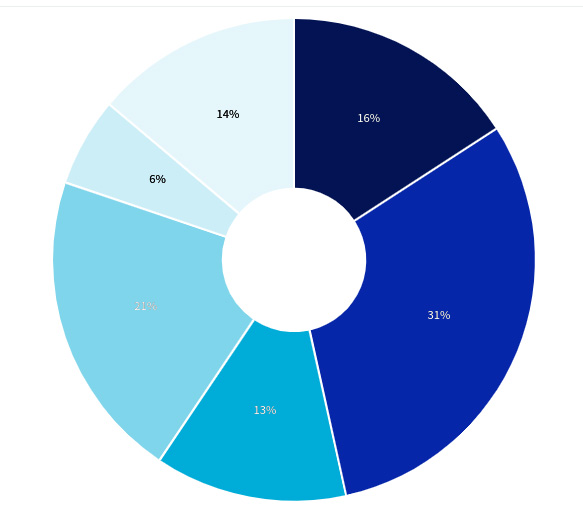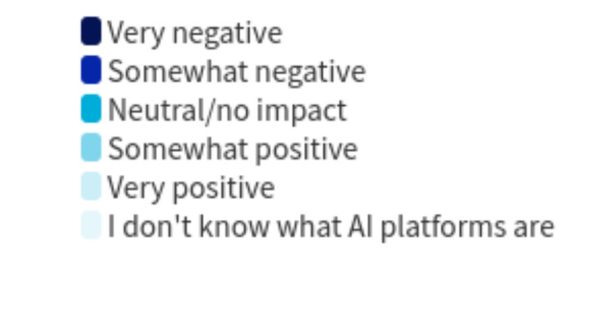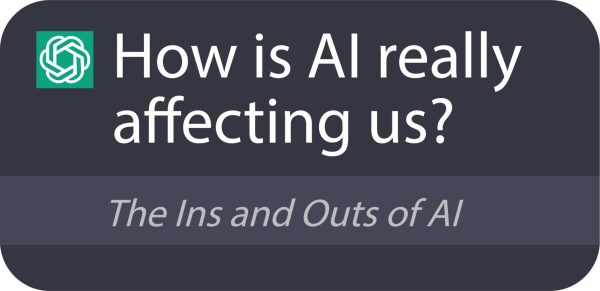
Artificial intelligence is one of the most prevalent concepts that has increased immensely in recent years, especially in classroom settings. Stuck on a math problem? Ask AI to solve the question. Want to summarize an annoyingly long reading for a history class? Use AI to save time. Need help with starting points for your big English essay? Just mention the topic to ChatGPT, and you will have dozens of ideas in less than a minute, if not more. Don’t have the time to research the cheapest place to go for a vacation? Ask AI. Confused about workout ideas that meet your goals? AI is less than a few clicks away. Need a resume template? AI will have it ready in 10 seconds. Want to text a friend, but your hands are dirty? Tell Siri to do that. Need to turn on the lights in your room? Alexa has got you covered.
AI has seen a tremendous increase in its usage from the moment it was introduced. According to Forbes Advisor in 2023, ChatGPT, a popular free-to-use AI system, had 1 million users within the first five days of being available. Additionally, the AI market size is expected to reach $407 billion by 2027, a substantial growth from 86.9 percent revenue in 2022, according to Forbes Advisor in 2023.

According to Colorado State University Global, in 2021, artificial intelligence(AI) will be “a technology that allows machines and computer applications to mimic human intelligence, learning from experience via iterative processing and algorithmic training.” But what does this mean? AI is the science of making machines that act similarly to humans. It can recognize patterns in large amounts of data and test and adapt each time it processes data.


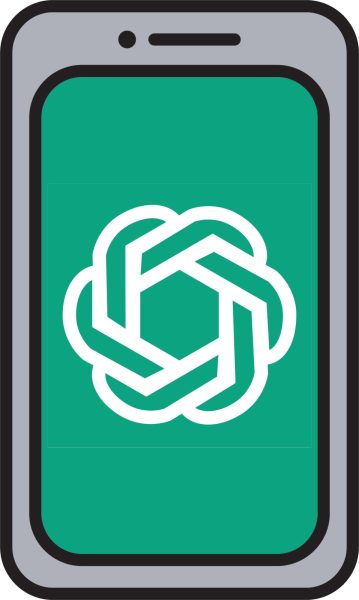
According to Colorado State University Global in 2023, AI systems function by combining large sets of data with intelligent and processing algorithms to learn from the patterns and features in the data they analyze. Its efficiency is a product of the tests AI performs to measure its performance every time it runs a round of data processing. Additionally, it can run through thousands, even millions of tasks, exceptionally quickly, learning a great deal and becoming extremely capable at whatever it is trained to achieve in minimal time while never needing a break.
One of the most advantageous things about AI is its versatility: according to CSU Global in 2023, AI is not a computer system or just an application; it is a whole discipline, a science, in itself.
But as the phrase goes, “What comes easy won’t last; what lasts won’t come easy.” Several have wondered if the seemingly amazing benefits of AI are only outwardly attractive.

According to Forbes Advisor in 2023, AI “can be referred to as a magnificent creation of next-generation developments and progressions which leads to end-to-end automation and orchestration of various complex operations.” It also expands on some of the ways AI is useful:
- Since it is a programmed system, AI-enabled computers or any similar devices to accomplish efficient and accurate results, thereby reducing human errors.
- AI can handle huge chunks of data and process it through interpretation and transformation.
- AI can automatically complete monotonous routine tasks such as data-related tasks, customer-focused business tasks, email responses, texting a friend without picking up the phone, etc. This allows humans to focus on tasks requiring human abilities and saves them time.
- AI-based chatbots and AI-based digital assistants like Alexa and Siri have helped in daily lives by providing information, addressing queries and providing information on demand. They help with tasks from school assignments to concept or topic queries, translations of words in different languages, and so much more.
- In terms of the medical field, AI has started to assist complex medical procedures such as radiosurgery. It has been able to predict health risks rapidly without medical staff having to monitor patients continuously.
- Due to AI’s 24/7 availability, it can be accessed at all times and unlike humans, is productive at all times.
- According to Emeritus, a company that provides online professional programs with top universities from across the globe, in 2022, banks can use AI to detect fraudulent transactions for banks.
- AI is also utilized in the stock market since it can recognize trade patterns and determine the right time and stock to invest in.

- AI only recognizes patterns that it has seen before. Cornell University conducted a study in which a photo of a school bus was shown to AI. The AI identified it as a school bus, but when the photo was rotated 90 degrees, it could not identify that the image was still of a school bus.
- AI is being used for increasingly more important subjects but can be biased. In 2019, a study by the University of California at Berkeley found that a healthcare algorithm used nationally to identify which patients should go into intensive care programs was racially biased.
- Deepfakes, videos of a person in which their face or body have been digitally altered so that they appear to be someone else (according to the Oxford Dictionary) have been creating problems for celebrities and politicians. Deepfakes are used to scam and defame celebrities or politicians by making videos where it looks like a person is doing something or saying something they have not.
- AI can incorrectly determine the solution to a problem, which can turn out to be devastating. In 2016, the autopilot AI in a Tesla Model S failed to identify a left-turning truck, resulting in the death of the driver.
While AI has several advantages and disadvantages, the concerning question about AI is whether it is truly original: Is the information AI draws its data from unbiased and authentic?

According to an article by Forbes Advisor in 2023, nearly 97 percent of business owners believe that AI will improve their business, and the US Census Bureau has found that over 13 percent of US businesses already utilize AI.
But, as Scientific American mentioned in 2023, Artificial Intelligence, like the humans who develop and program it, is far from perfect. AI bias can be found in the initial training data, the algorithm, or the predictions that the algorithm makes, according to a 2023 article by IBM, an American multinational technology company. These biases halt the progress of everyone who utilizes AI since it reduces its potential. Businesses especially are harmed by this as they cannot incur benefits from systems that produce misrepresented results and cultivate misunderstanding between groups of people: research has shown that AI can frequently use biased sources. These can be towards or against certain groups of people, including but not limited to people of color, women, disabled people, the LGBTQ+ community, and more.
This can occur due to various reasons:
- If the data is concentrated on only one particular concept, AI might not be most efficient at recognizing others. To illustrate, the article by IBM mentions that if the data AI receives for facial recognition is predominantly from white people, then it can misrepresent people of color. It can also produce inaccurate results if programmed to include diversity for every input, which proved problematic in Google’s Gemini AI. When a prompt such as “Can you generate images of the founding fathers?” was put into Gemini AI, the results included a majority of people of color and women, which is historically inaccurate.
- Certain characteristics with inconsistent or overrepresented labels could also cause a bias in AI. To illustrate, AI that comprises inconsistent labeling can eliminate qualified job applicants as it only looks for what it is programmed to. Other excluded labels are overlooked.
- Since AI is essentially a product of humans, the biases and preferences of the human who programs it will likely be transferred to the AI. This can be as visible as tilted data sets or preferences for a particular group or remain invisible if it is presented to a group of people who primarily contain the same biases.
These biases, as they are challenging to recognize, can amplify in the future if left unchecked, thus tilting massive sets of data and algorithms to a particular side. This, then, also affects the human population and their warrants.
Some impacts are subtle– AI’s speech-recognition inability to understand non-American accents– while some are harmful — according to the IBM article, healthcare algorithms can make errors if they’re only trained on a subset of people (such as white people, those of a specific age range or even people with a certain stage of a disease), as well as racially biased police facial recognition software can increase wrongful arrests of Black people.
The shortcoming of the harmful effects is that once someone has used the software, it is ingrained in their warrants, and research has shown that it retains itself even after AI usage is stopped. According to a study conducted by Bloomberg from December 2022 to February 2023 , they concluded that generative AI may display stronger racial and gender biases than people do. Since the data AI gathers its information comes from humans, and is, naturally, biased, AI can detect a pattern, and display it more directly than humans.
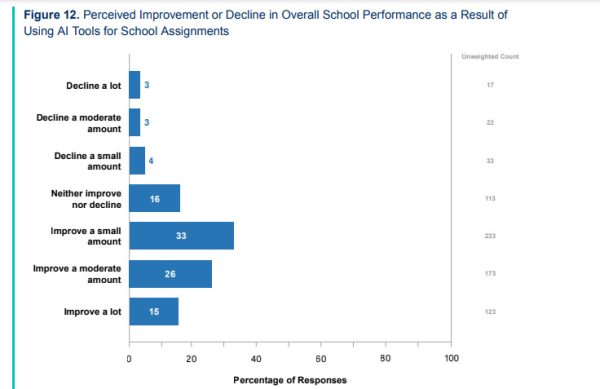

AI has been used in education for over a decade by teachers with the use of programs such as Aleks, but now more than ever is being used by students, too. The Office of Educational Technology states some ways AI can be used positively to enrich education: speech recognition to support students with disabilities, multilingual learners, and others who would simply benefit from the higher adaptability and personalization that AI could provide. The office also said that AI could be used to improve teachers in “finding, choosing, and adapting material for use in their lessons.”
Not all uses of AI in the classroom are beneficial or improve education. Research from American College Testing (ACT) showed in a survey that almost half of the students had reported using AI. Of those half, another half reported using AI programs to complete school assignments. Most assignments were related to writing for language arts or social studies courses. Seventy-four percent of survey respondents believed that their performance in school would improve if they used AI for assignments.
Educators believe AI will have a negative impact on teaching over the next five years since students are using AI to complete assignments rather than doing them themselves. A survey by Education Week last year demonstrated this, with 47 percent of educators who took the survey responding that they thought AI would either have a subtle or significantly negative impact on teaching. Only 27 percent thought it would have a very or somewhat positive effect (The remaining percentages either believed it would have a neutral impact or weren’t aware of what Artificial Intelligence programs were.)
Artificial Intelligence has seen a tremendous increase in its applications in various fields of usage by all groups of people for multiple purposes. As mentioned in a 2023 article by Our World in Data, 90 percent of AI experts said that Human-level Artificial Intelligence could exist within the next 100 years. But, with increasing popularity, many are starting to step back and realize the consequences of what might be utilized so much in the future. According to IBM in 2023, “Identifying and addressing bias in AI begins with AI governance, or the ability to direct, manage and monitor the AI activities of an organization.”. This will create frameworks to guide the responsible development and use of AI technologies. This can attempt to remove the biases in the data from which AI derives its information.
